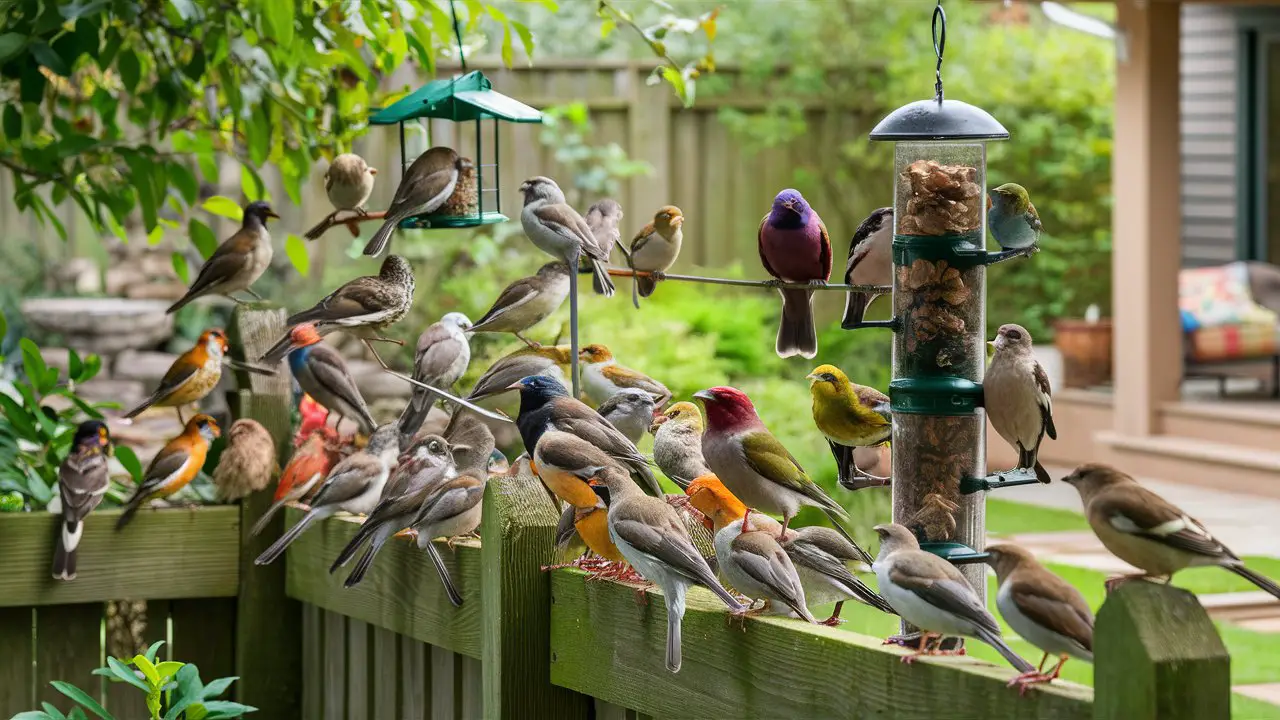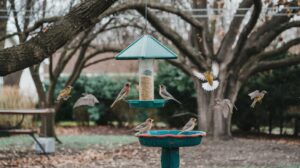As an amateur ornithologist, you know the thrill of spotting a rare or unfamiliar bird in your backyard. With over 800 species of birds that call North America home, proper identification is key to an enjoyable birdwatching experience. In this article, you will learn helpful tips for identifying common backyard birds through sight, sound, behavior, and habitat. Getting acquainted with bird field guides and recording your sightings will make you a better birder. Follow along to sharpen your bird identification skills and appreciate the diverse avian life right outside your window.
Gear Up for Bird Identification
To properly identify birds, you’ll need the right equipment. A good pair of binoculars, preferably 8×42 or 10×42, will allow you to view birds from a distance without disturbing them. ###Look for binoculars that are waterproof, fog-proof and have multi-coated lenses for maximum clarity. A field guide that focuses on birds in your region is also essential. ###Look for one with detailed descriptions and color images of birds in different plumages. Some recommended guides include The Sibley Guide to Birds and the National Geographic Field Guide to the Birds of North America.
You’ll also want a notebook to record your observations. ###Note details like the bird’s color and markings, the shape and color of its bill, the shape of its tail, and the pattern of its wing beats. Also record behaviors like what and how it’s eating, songs and calls, time of day and location of sighting. These notes and details will help you narrow down possibilities and make an accurate ID.
A camera can also be useful for capturing images of birds that can later be used for identification or documentation. ###Look for a camera with a fast shutter speed, large zoom and the ability to shoot in burst mode. Capturing birds in flight or in motion can be challenging, so a camera suited for action and wildlife photography is best.
With the right gear and some practice, you’ll be identifying birds in your backyard and beyond in no time. Pay close attention to details, compare your observations to field guides, and don’t be afraid to take plenty of pictures. Bird identification does get easier with experience as you start to recognize telltale markings, songs and behaviors. Soon you’ll be impressing friends and family with your ability to spot a Yellow Warbler or Northern Flicker from far away!
Learn to Recognize Birds by Sight
To become adept at identifying birds, you must train your eyes to recognize distinct markings and color patterns.
Size and Shape
Note the overall size and shape of the bird. Is it plump like a robin, slender like a hummingbird, or large like a crow? The silhouette of a bird can provide important clues to its identity. Pay attention to details such as the shape of the bill, wings, tail, and head.
Color Pattern
A bird’s color pattern is one of the most useful identification features. Note the colors of the head, wings, belly, tail, and any stripes, spots or patches. Also note any iridescent or metallic sheen to the feathers. Some birds like blue jays and cardinals are vividly colored, while others like sparrows are more drab. Watch for any color changes during the breeding season or between male, female and juvenile birds.
Behavior
How a bird moves and behaves can also aid in identification. Note how it walks, hops or climbs. Watch how it flies—does it soar, flap rapidly, glide, or make short flights? Listen for any calls or songs and note the time of day or season. Some birds, like woodpeckers, have distinctive feeding behaviors like climbing up tree trunks or hammering on wood.
By observing a bird’s size, shape, color, behavior, habitat, and location, you can determine its identity. With regular practice, bird watching will become second nature and you’ll soon be recognizing all the common birds in your area. Keep a field guide handy to confirm your identifications and learn about new species you encounter. The key is patience, persistence, and an attentive, curious eye.
Identify Birds by Their Songs and Calls
Bird songs and calls are a useful way to identify birds in your backyard. Male birds sing to establish territories and attract mates during breeding season. Females sing less frequently, using calls primarily to communicate with their young. Learning some of the common songs and calls in your area can help you determine what kinds of birds frequent your yard.
Listen for Distinctive Songs
Some birds like the Northern Cardinal have loud, distinctive songs that are easy to recognize. The cardinal’s song is a series of metallic chips and whistles. The Mourning Dove has a melancholic cooing song. Pay attention to the time of day the birds are singing, as some birds like the American Robin are most vocal at dawn and dusk. With practice, you’ll get better at identifying birds by sound alone.

Learn Common Call Notes
Birds also use shorter call notes to communicate with each other. For example, the chickadee’s call is a familiar chick-a-dee-dee-dee. Woodpeckers like the Downy Woodpecker and Northern Flicker also have distinctive call notes. The Downy Woodpecker’s call is a short whinnying trill, while the flicker’s call is a loud, emphatic “wick-wick-wick”. Blue Jays are known for their loud, raucous jay! jay! calls.
Use Field Guides and Online Resources
Field guides, audio recordings, and online resources can help you learn to identify birds by ear. Many websites offer recordings and sonograms of bird songs and calls. Some also provide tips for distinguishing similar-sounding birds in your area. With regular listening, you’ll be adept at using birdsongs and calls to determine what kinds of feathered friends are visiting your backyard.
Use Field Guides and Apps for Bird Identification
Using resources specifically designed for identifying birds, such as field guides and mobile apps, is key to learning bird identification. Field guides provide detailed information on birds in your local region, including high-quality photographs, descriptions of distinguishing features, typical habitats, and bird calls. Carry a field guide with you on birding excursions to help identify birds in the field.
Popular field guides in North America include the National Geographic Field Guide to the Birds of North America, Audubon Field Guide to North American Birds, and Peterson Field Guide to Birds. These field guides cover hundreds of species with range maps indicating where each bird can be found during the year. Study the guides to familiarize yourself with birds in your area before heading out. Pay attention to details like the bird’s size and shape, coloration, markings, bill shape, and tail pattern. Listen to the provided audio clips of birdcalls and songs to train your ear.
Mobile apps, like Audubon Bird Guide, Merlin Bird ID, and eBird, provide an interactive way to identify birds. Audubon Bird Guide and Merlin Bird ID feature photos, descriptions, and birdcalls for over 500 species. Enter details about a bird you’ve seen, like location, color, size, and habitat, and the app will provide identification suggestions. eBird allows you to record and share your bird observations while using the app to identify birds. These birding apps provide an easy way to identify birds in the field and keep records of your sightings.
With regular use of field guides and bird identification apps, you’ll develop stronger bird identification skills. Paying close attention to key details, learning bird anatomy, understanding habitat preferences, and recognizing bird vocalizations are all part of the process of becoming an expert bird identifier. Spending time observing birds in the field and testing your new knowledge will help cement that learning. Before you know it, you’ll be identifying birds with confidence.
Bird Identification Tips and Tricks
To properly identify birds in your backyard, it is important to observe key physical characteristics and behaviors. Some tips and tricks to keep in mind:
Focus on distinguishing features
Look for characteristics like color, markings, size and shape. Pay attention to details such as wing bars, eye rings, crowns, and tails. Birds often display vibrant colors and intricate patterns during mating season in spring. Note the bird’s silhouette and profile to determine if it is a songbird, waterfowl or bird of prey.
Observe the bird’s behavior
A bird’s behavior provides valuable clues to its identity. Note if the bird hops or walks, swims or wades, climbs or clings. Watch how it moves through trees or flies. Some birds, like woodpeckers, nuthatches and creepers, grasp onto tree trunks. Others, such as flycatchers, kingbirds and phoebes, swoop out to catch insects in mid-air.
Listen for distinct sounds
Bird calls and songs offer auditory identification cues. Learn to distinguish alarm calls, territorial songs, and mating calls. Many birds have a repertoire of vocalizations for different purposes. With practice, you’ll recognize familiar sounds and learn to associate them with specific birds. Some birds, like owls, are more vocal at night whereas songbirds are most vocal during the day, especially around sunrise and sunset.
Consider habitat and location
The type of habitat and location a bird chooses provides useful identification clues. Woodpeckers, nuthatches and creepers frequent forests and woodlands. Waterbirds inhabit lakes, rivers, marshes and coastlines. Birds of prey are often spotted soaring over open fields or perched on fence posts scanning the ground for prey. Pay attention to the time of year as well, since some birds are only present during certain seasons or migrate annually.
With regular observation, you’ll become adept at identifying the birds in your area. Keep field guides and apps on hand to look up birds you cannot identify and confirm the ones you recognize. Most importantly, have patience – birding takes practice. Before you know it, you’ll be spotting birds left and right!
Don’t Miss a Thing! Enhance Your Wildlife Photography with Ultra-X Night Vision Goggles.
GET NOW!






